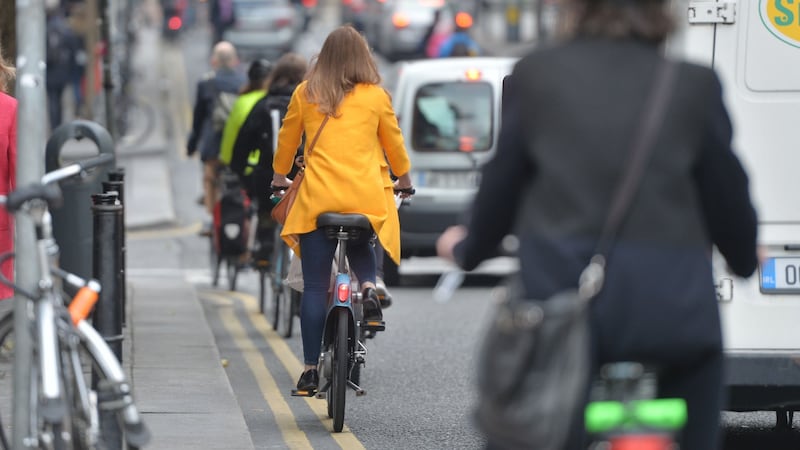George Orwell's citations of emblematic Britishness in The Lion and the Unicorn: Socialism and the English Genius (1941), include "old maids bicycling to Holy Communion through the mists of the autumn mornings". And in his poem Church Going" (1955), Philip Larkin describes how "Hatless, I take off/My cycle-clips in awkward reverence."
I heave a nostalgic sigh for bicycling old maids, and for Larkin, with cycle-clips and raincoat, pedalling home through the drizzle for a damp evening of jazz and pornography. Unlike yesteryear’s bicyclists, placidly merging into the background, today’s wheelers – as their eye-scorching apparel demands – stand out. And understandably so, since attention-grabbing garb could be the difference between life or death.
The evidence for the health benefits conferred by cycling is overwhelming, and it is encouraging to note that in April 2016, the Central Statistics Office's reported that almost 57,000 people cycled to work in Ireland, an increase of 43 per cent since 2011.
However, one coarsening effect of our culture is a self-righteous sense of entitlement. This has seeped on to our thoroughfares, resulting in an increased risk of conflict – accidental or intentional – between any combination of cyclists, motorists, motorcyclists and pedestrians, if not tempered by self-discipline, self-control and vigilance.
And cyclists aren't immune to commercial pressures. For example, in a recent survey of the gig economy undertaken by University College London researchers found that cycle couriers were "at risk of tiredness, distraction by their work app and taking risks. Two-wheeled couriers also reported worries of being attacked and adverse weather conditions, when their companies would incentivise couriers to go out to work. Across both two and four-wheeled couriers, only 25 per cent agreed that the company cared about their safety whilst working."
According to Ireland's Road Safety Authority (RSA) in 2018 there were 142 fatal collisions and 149 fatalities on Irish roads, which "represents 1% increase in collisions (+2) and 4% fewer deaths (-7) compared to provisional Garda data for the full year of 2017. Of the 149 fatalities, there were 62 drivers killed, 21 passengers, 42 pedestrians, 15 motorcyclists and 9 pedal cyclists."
Awareness
In a European context, the European Road Safety Observatory reported 2,820 cycling fatalities in 2006, dropping by 27 per cent to 2043 in 2015.
But as a recent study notes, in Ireland “there has also been a 50 per cent rise in cycling deaths in Ireland between 2016 and 2017 despite campaigns to raise awareness and safety around cycling such as ‘Overtaking Cyclists’, ‘Vulnerable Road Users’ and ‘Cyclists - We all share the road’.”
This was cited by Dr Christopher Fenelon and colleagues of Dublin's Tallaght University Hospital in their study: A growing problem: Cycling Referrals to the National Centre for Pelvic and Acetabular Fracture Management in Ireland, published in the Irish Journal of Medical Science. Noting that cycling-associated injuries have increased with rising participation – "a recent study showing a 200 per cent increase in the number of referrals for bicycle-related trauma to the Irish National Spine Treatment Centre" – the researchers aimed to quantify both cycling-related pelvic and hip socket fracture referrals in Ireland and outcomes, including injury patterns and cost.
Between January 1st, 2016, and December 31st, 2017, of 456 pelvic and acetabular referrals to Tallaght, 29 (6.4 per cent) were cycling-related, a 90 per cent increase on 2016. The mean age was 51.7 years; 86.2 per cent were male; and the mean cost of treatment for patients who underwent surgery was €11,757.

Lead author of the study Dr Fenelon declined to comment on his team's findings but Cycling Ireland, the country's governing body for cycling, welcomed the research.
How should the problem of cycle-related injury be addressed?
Fenelon and colleagues state: “As participation in cycling grows, increased investment in awareness and safety needs to be focused at protecting this vulnerable group of road users.”
In Cycle Safety, the RSA advises:
- Wearing a helmet reduces the risk of getting a head injury by 69 per cent to 85 per cent;
- When cycling you should always wear fluorescent and reflective clothing;
- Children younger than 12 should not ride bicycles in any type of traffic;
- Never cycle on a footpath unless it has a cycle track;
- Never cycle side by side with more than one cyclist.
Tram tracks
The RSA’s advice urging caution on tram tracks is prudent, especially following the death of a medical student in 2017 on Edinburgh’s Princes Street, when one of her wheels got trapped, causing a collision with a vehicle.
Barbara Connolly, Cycling Ireland's cycling standard development officer, told The Irish Times: "Cycling remains an essentially healthy and safe pursuit and while numbers cycling continue to grow, the organisation notes that in 2018, fatalities reduced to nine, a decrease of 50 per cent on 2018.
“Cycling Ireland acknowledges the increasing presence of dedicated cycling space on our roadways, and would encourage all road users to always be conscious of safety on the road network by travelling at a safe, appropriate speed, by remaining constantly aware and by being particularly mindful of vulnerable road users such as cyclists and pedestrians.”
Cycling Ireland also supports the Cycle Right programme, the national standard for cycle training, providing practical cycle safety and skills training to promote competent and confident cyclists.
Cycling is a healthy, enjoyable pastime, sport and commuting option, but its safe pursuit demands a level of awareness exceeding that exercised by Orwell’s bicycling old maids.



















